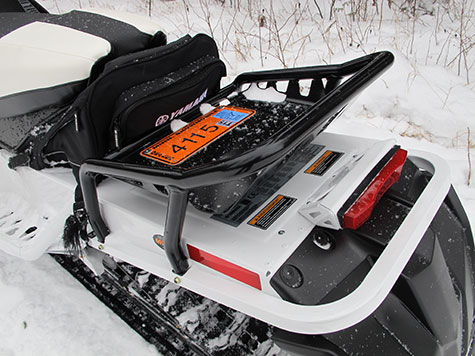Introduced for 2015 with a broad windshield, spacious and protective cab, comfort-tuned suspensions and a tunnel-mounted storage rack that gives it a square-shouldered, masculine look, the Yamaha SR Viper S-TX DX snowmobile was designed for a long day – or days – on the trail.
The tall Yamaha SRV front suspension on our demo felt plush over small bumps, yet it was resistant to bottoming on bigger bumps. In typical SRV/ProCross fashion, the inside ski consistently stayed on or near the ground when carving through corners. The tunnel rack was a convenient place to strap on a small bag with a change of clothes and head out for an overnight stay at a lodge or hotel on the trail.
Low- to mid-range power from the high-performance 1049cc four-stroke triple was class competitive among 600cc two-strokes. The powertrain hit hard out of the hole for quick acceleration up to around 50 mph, and we could feel and enjoy the smooth, usable torque to accelerate out of corners or lighten the front end over small bumps and moguls. Once it hit the north side of the mid-range, the rate of acceleration leveled off.
Experience with the SR Viper platform during the past two years has shown that we prefer the mid-length versions like our 2015 S-TX DX that had a 141-inch track. The crossover models seem to respond more predictably to driver inputs, and the weight bias feels better balanced from front to rear.
Despite that our SR Viper S-TX DX weighed, on average, 40.5 pounds more than our seven other 2015 demos – not including our Ski-Doo Summit X that was based in Bozeman, Montana, and was not weighed on our borrowed set of Intercomp professional scales – it carried its bulk well while rolling down the trail. The mass was localized and felt like the chassis carried its weight between our knees. As a result steering felt light, but that darn large diameter handlebar tube and long reach to the brake lever made the sled seem bigger than it needs to feel.

Two aftermarket accessories we tested on our 2015 Yamaha SR Viper S-TX DX made notable improvements to the sled’s power and suspension performance. A lightweight aftermarket muffler helped the engine breathe easier so it accelerated quicker and picked up a few clicks on the top end.
Stock rear suspension performance was good on smooth to moderately bumpy trails, but the uncoupled, Dual Shock SR 141 rear suspension was over-worked by sharper and harder bumps until we changed the motion ratio with an aftermarket linkage kit from Hygear Suspension (Freeville, New York). That kit, along with a different coil-over rear shock, helped the suspension absorb bumps and inclines without bottoming and deflecting, so the sled would track straight and feel more predictable through bumpy sections.
Yamaha reworked the S-TX DX for 2016 by splitting the platform into two separate models, including the S-TX 146 DX – a full-featured trail cruiser with an auxiliary gas tank. The S-TX 137 DX replaces the model we rode last winter. It has the Dual Shock SR 137 rear suspension with torsion springs, and frankly, that’s a better rear suspension for the trails where adventure-class snowmobile riders log most of their miles.
Sled: 2015 Yamaha SR Viper S-TX DX
MSRP: $13,099
Modifications: Giant Loop Revelstoke tunnel bag, Zigzag handlebar bag; D&D Racing Quiet Tech muffler; Hygear Suspension 141 Pro Linkage kit with Custom Axis shock; Yamaha Tuner wear bars
Miles ridden: 850
Weight: 605 pounds, bone stock with full gas tank and spare belt
Average MPG: 14.12

I was just wondering how that machine is on drive belts. I have heard that the big force drugs having so much torque rather tear through these expensive belts yet I have not seen anyone ask that question or have obviously seen an answer to it. Thank you very much.
I heard the clutching and skis that come on these things is terrible. I always wanted one but couldn’t fully trust that it was essentially a Yamaha engine but everything else was Arctic Cat. A chassis that was never really designed to house a 4-stroke has had one squeezed into it and I am not so sure that that chassis was tweaked and adjusted enough to compensate for all the additional weight. I image a lot of the belt life would improve with better clutching. They should try the Adapt clutches on the Yammy engine and ditch Yamaha’s clutches/clutching which is often conservative at best.